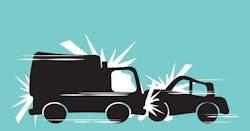When an employee is injured in a work-related car accident, which should be the proper legal remedy for them: applying for workers’ compensation, or filing a lawsuit for a personal injury liability claim when the other driver is at fault?
The usual recourse for the employee is workers’ comp, but the ideal situation would be to bring a personal injury claim, although it is seldom allowed, argues attorney Jonathan Rosenfeld of the Rosenfeld Injury Lawyers law firm.
Common examples of people whose job requires them to drive are truckers and delivery drivers who drive company vehicles on a daily basis. Even people who take their own personal car with them on sales calls are considered to be on the job if they have an auto accident when they’re behind the wheel. This also applies when they are in a company car or pickup truck.
“In an ideal case, the injured worker would be able to both file a workers’ comp claim and file a lawsuit against another person after a motor vehicle accident,” he says. “It would be both a work-related injury as well as a personal injury.” In most cases, workers must pursue a workers’ comp claim as their exclusive remedy and are not allowed to file a personal injury lawsuit against their employer.
“The entire reason for the workers’ compensation system is to protect employers while still allowing injured employees to recover financial compensation,” Rosenfeld asserts. Workers cannot file both a workers’ comp claim as well as a civil lawsuit against their employers.
They also do not get to choose between a workers’ comp claim and a negligence suit against their own company. Their employer is largely protected unless certain very limited exceptions apply. However, the general rule may not apply if the employee has been in a work-related accident with a third party. In this case, the driver may be able to sue the person who was responsible for the accident in a personal injury case, according to Rosenfeld.
Being able to sue a third party for a car accident would increase the employee’s possible recovery because workers’ comp claims are limited in some respects, he observes. While the employee can recover for lost wages and medical bills in a workers’ comp case, they are not able to recover for things such as pain and suffering, future lost earnings, mental anguish and property damage to their personal vehicle.
“The ideal situation is to be able to both file a workers’ comp claim and to be able to file a lawsuit against a third-party for a work-related auto accident. You could also file a claim with an auto insurance company,” Rosenfeld points out. In this situation, the employee could sue someone else whose actions are responsible for their injuries in the accident, if this negligence was the cause of the accident.
Another way that an employee could sue a third party for injuries is if it is a product liability lawsuit against the maker of the vehicle or a part. If the injuries were due to a defective car or truck, you can file a lawsuit against the manufacturer and likely recover damages much higher than you would if you filed a claim through a workers’ comp claim.
Rosenfeld explains that even in cases where the employee driver was at fault for the accident, they are still allowed to file a workers’ comp claim to pay injuries they may have incurred while they were on the job. “This is a no-fault system that is largely not concerned with negligence or who was responsible for the accident. There are very few exceptions to this.”
However, if the employee was engaged in intentional misconduct or reckless behavior, such as driving drunk, they may not be able to file a workers’ comp claim. They also may not be allowed to file a claim if they were using a work vehicle on their own personal time or for a nonwork-related reason.
You can think of workers’ comp as a middle ground, Rosenfeld suggests. “The worker is protected, even if they were at fault for the accident. However, their amount of recovery is limited because they cannot recover for certain things.”
About the Author

David Sparkman
David Sparkman is founding editor of ACWI Advance, the newsletter of the American Chain of Warehouses Inc. He also heads David Sparkman Consulting, a Washington, D.C. area public relations and communications firm. Prior to these he was director of industry relations for the International Warehouse Logistics Association. Sparkman has also been a freelance writer, specializing in logistics and freight transportation. He has served as vice president of communications for the American Moving and Storage Association, director of communications for the National Private Truck Council, and for two decades with American Trucking Associations on its weekly newspaper, Transport Topics.
